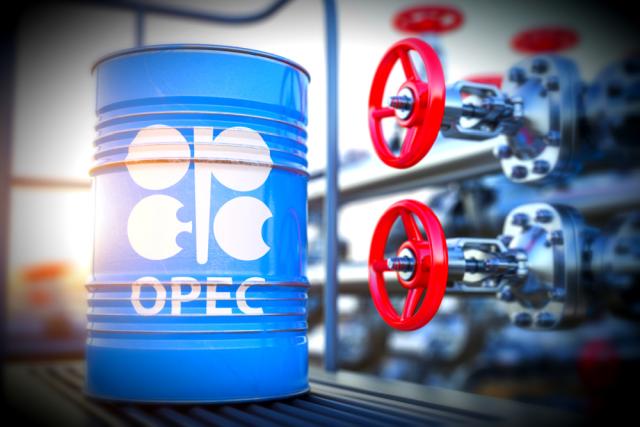
While OPEC’s decision to increase oil production might have some short-term effect on global oil prices, the group isn’t a “swing producer,” said Steve Reese, CEO of Reese Energy Consulting Co. (Source: Shutterstock.com)
OPEC+’s agreement to add 50% more crude production to global supply addresses the Biden administration’s lobbying effort, but insiders say the supply shift is unlikely to meet the U.S. President’s goal of lowering gasoline prices.
Higher prices at the pump are likely here to stay for at least the next few months, Baker Botts Partner Carina Antweil told Hart Energy.
“Inflationary prices at the U.S. pump are being driven in large part by a lack of refining capacity. Even if production were to increase substantially, there is no more U.S. refining capacity to process that crude and get it to the pump,” Antweil said.
E&P companies are unable to meaningfully ramp up production due to supply chain disruptions, she added. And even if they did, U.S. does not have the raw materials or labor to refine the product once it’s produced.
Additionally, she noted that supply remains depressed and demand will only increase over the summer as Americans take vacations and consume more gas at the pump.
“This confluence of economic factors means that higher prices are inevitable,” Antweil said.
Oil per barrel surges
OPEC’s announcement did nothing to lower crude oil prices either.
In fact, price per barrel topped to a three-month high of $120 on June 6 after OPEC’s de facto leader Saudi Arabia raised July official selling price of its flagship Arab light crude to Asia.
Moreover, OPEC’s key producers are running on low spare capacity, which is raising eyebrows on how much OPEC can help balance markets.
“The current reality is that there isn’t much spare capacity outside of Saudi Arabia and the UAE, so while the agreement to boost output is a step in the right direction, it’s not meaningful when you look at the deficit that we’re currently facing worldwide,” Antweil said.
Additionally, experts are concerned that OPEC’s planned output increase isn’t big enough to replace lost barrels and balance the oil markets.
“It remains to be seen whether a modest quota increase of 216,000 b/d of capacity in each of the next two months will be enough calm perceptions about tight supply,” said IGM Energy’s Principal Advisor Ian Simm.
The challenge will be greater, Simm said, particularly as the EU moves to stop buying around 90% of its current Russian volumes.
Swaps and Swings
“While Moscow is likely to swap Europe for Asia, it will face stiff competition there, while any further drop in Russian production must also be accounted for in talk of OPEC+ hitting output targets, placing greater burden on the few countries—Saudi Arabia, the UAE and, to a lesser extent, Iraq—that hold the vast majority of spare capacity,” Simm noted.
Overall, Simm said that concerns about recession are likely to have a greater influence on price than the latest OPEC+ output pact. However, the deal’s “longer-term staying power” will continue to impact market fundamentals.
While OPEC’s decision to increase oil production might have some short-term effect on global oil prices, the group isn’t a “swing producer,” said Steve Reese, CEO of Reese Energy Consulting Co. Instead, if North American producers overcome supply chain constraints, they can help supply the market with affordable energy.
“If the U.S. supply chain can begin to get lined out, many Permian, Bakken, and Midcontinent producers are poised to ramp up their drilling schedules, putting more U.S. oil into the market, which continues to be the preferred clean, stable and reliable supply,” he said.
Recommended Reading
West Texas Hold ’Em: Permian Plays Pipeline Poker
2024-07-16 - The consensus is that the Permian Basin needs another major gas pipeline soon. Midstream companies are trying to figure out when … and who will make the move.
New Major Permian NatGas Blackcomb Pipeline Reaches FID
2024-08-01 - WhiteWater Midstream announced a joint venture to build the 2.5 Bcf/d Blackcomb pipeline, which would offer a new connection from the Permian Basin to South Texas.
Blackcomb Takes Lead in Permian Pipeline Race for 2026
2024-08-07 - With WhiteWater Midstream’s announced Blackcomb, other proposed lines by Energy Transfer, Targa Resources and Kinder Morgan’s may shift to a later date or be scrapped.
EnLink Expects Matterhorn Line Operational by September
2024-08-07 - EnLink’s JV partners cited the effects from Hurricane Beryl causing slight delays in the Matterhorn Express Pipeline.
Matterhorn Express, Partially Online, to Ease Permian Gas Bloat
2024-09-05 - The long-awaited Matterhorn Express pipeline is shipping small amounts of natural gas out of the Permian Basin, according to an E&P CEO.
Comments
Add new comment
This conversation is moderated according to Hart Energy community rules. Please read the rules before joining the discussion. If you’re experiencing any technical problems, please contact our customer care team.





